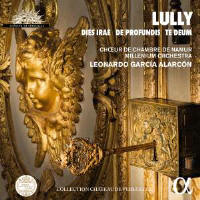Texte paru dans: / Appeared in: Alpha |
|
| " Warmly recommended. " | |
|
Reviewer: Barry
Brenesal Lully did not create that most emblematic of religious musical forms for Louis XIV’s court, the grand motet. That honor (barring any examples by lesser-known composers of the period that have as yet escaped notice) goes to Henri Du Mont. Jean-Paul Montagnier wrote in his essay, “French grands motets and their Use at the Chapelle Royale from Louis XIV to Louis XVI,” that the kings “attended religious ceremonies daily, not only to fulfill their duties as Rois Très Chrétien but also to perform their part in a state liturgy revolving around their royal bodies … it is enough to say here that the Chapelle Royale not only hosted daily Masses but also various magnificent ceremonies….” Even the Low Masses were elaborate affairs that typically used a good deal of music, and much of that during Du Mont’s time was provided by a pair of sous-maîtres appointed by Louis XIV.
Other composers contributed, as well, and eventually the number of sous-maîtres hired by the Sun King swelled to four a year, in rotating three month cycles. Although he never held a position in the hierarchy of the royal religious music establishment, Lully composed 11 grands motets for the Chapelle Royale, according to Thomoas Leconte’s liner notes. (He does not specify individual works; James Anthony in French Baroque Music from Beaujoyeulx to Rameau names 12). The first, a Miserere (Hervé Niquet directed a fine recording of it on Naxos 8.554397), is dated 1664. When it was heard in 1672 at a state funeral, Madame de Sévigné, that inveterate letter writer, noted of its Libera me that “I do not believe any other music to exist in heaven.”
Louis XIV thought much of them as well. In 1684 he ordered (and paid for) the publication of six of these grands motets, including those heard on this disc. All three, excellent examples of Lully’s craft, applied the composer’s rich theatrical sense to the sacred realm, where interest is maintained through a constantly shifting succession of musical elements. It does not lack for expressive moments—such as the heavily weighted orchestral counterpoint to the intoning of the original “Dies irae” plainchant; the same work’s minatory “Mors stupebit” recitative giving way to the homophonic choir in five parts on the gentle “Liber scriptus proferetur”; and the slow, thrice-repeated statement of “Sanctus,” situated cleverly to interrupt a swiftly moving harmonic progression in the Te Deum’s triumphant “Tibi omnes Angeli” movement. Yet it is quintessentially drama, taking pride in its contrapuntal display and rewarding its soloists with passages as sweet or brilliant as any Lully wrote in his operas. These works demand a conductor with theatrical instincts, and Leonardo García Alarcón certainly supplies that. I’ve taken exception in the past to the wide and anachronistic range of instrumental color he has occasionally imposed on opera recordings. Here, though, that isn’t an issue, and his ability to shape expressive gestures within the music through added rests, dynamics, ornamentation, and articulation marks is both shrewdly judged and sensitive to the needs of the music itself—as in the repeatedly halting performance of the Dies irae’s “Pie Jesu.”
The edition of these grands motets found in the Philidor Collection (so-called because Amdré Danican Philidor the Elder led a team of musicians who created handwritten copies of some of the French royal court’s music dating as far back as Henri IV) lacks marks; and a musician of that period would have usually been expected to adapt works to their own requirements and interpretation. Understanding interpretive limits was part of a good musician’s training. Alarcón succeeds in a way that never sounds mannered. The forces he employs are reasonable in size. The Chœur de Chambre de Namur here consists of 18 singers across five parts, SATBarB in a 4–4–3–3–4 distribution. In addition, there are six solo vocalists—most notably, high tenors Matthias Vidal and Cyril Auvity providing a level of extra brilliance with their 10ths above the tonic in final cadences. Only Alain Buet is not fully up to the challenge; and while he is sketchy in his figures, Buet also performs with his usual refined tone and enunciation. The Millenium Orchestra (with Capella Mediterranea furnishing continuo) consists of 31 performers. Despite these fairly impressive numbers, there’s always a well-defined, tightly focused sound. This is, in short, a success from start
to finish. Warmly recommended. | |
|
|
|
|
|
|
|
Cliquez l'un ou l'autre
bouton pour découvrir bien d'autres critiques de CD |
|




